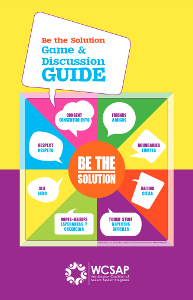Medium
Topic
- Guides & Activities
The "Be The Solution" Game & Discussion Guide encourages youth to discuss topics related to developing healthy sexuality, boundaries, and fulfilling relationships.
Each category of questions were carefully chosen to help youth in examining root causes of sexual violence and build protective skills. The sections are based on best practice such as sexual violence risk and protective factors and the Developmental Assets Framework.
The 2018 version continues two updates that are designed to increase the intentionality and accessibility of the Guide.
- For even deeper connection to root causes and best practices, there are new questions that examine the intersection of sexual violence and other forms of oppression; such as racism, ableism, and transphobia. We hope these are an easy-to-use way to begin these tough conversations with young people in your community. Additionally, this aligns with the state's 2017 Sexual Violence Prevention Plan principle of intersectional approaches in sexual violence prevention.
- The Guide has been translated into Spanish and adapted for cultural relevance. Ensuring greater language access and cultural consideration of resources is a priority. Additionally, this aligns with our state's 2017 Sexual Violence Prevention Plan principle of culturally and linguistically appropriate approaches.
Using the Guide:
As the facilitator, pick and choose from the suggested questions, Role Plays, and activities to best fit the goal of your group and any time limitations. Of course, customize these to reflect what is important to you and your community. The Guide is designed for a teen audience, please review before using to determine if it is appropriate for your group. You will find other guidance and considerations included at the beginning of the guide.
This Guide is designed to be a starting place for interesting and meaningful conversations. It's flexible and may be utilized in many ways, including but not limited to:
- During a one-time awareness program, for example at a SAAM community tabling event or family night. If there isn't an opportunity to establish ground rules and group trust, the facilitator may want to select questions that are easier to answer.
- As part of a multi-session prevention group with teens. You may use it as an ice breaker game to start each session, play it during an entire session, or find that you use the Guide without the game as discussion prompts to connect to your session learning objectives.
- Working with teen survivors; during advocacy sessions or as part of a support group. While this was not part of the original design, we have heard from advocates that this tool has been useful this way as it explores key concepts that are meaningful to survivors.
